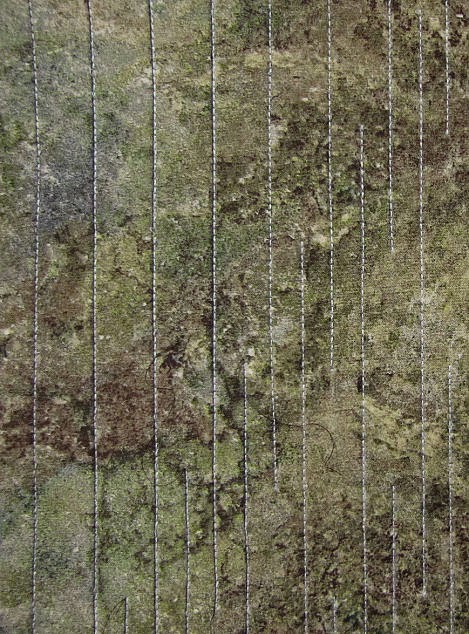 |
| Master pattern road map guiding proper placement of overlapping units |
My art group met early last week, giving me the thumbs up on my fabric choices for the fountain wall - not that there was much I could have done at that point if they hadn't. I'd fused fabric to the rest of the pieces of Stiff Stuff and done the satin stitching before the meeting. But it was a relief to have their approval along with substantiating reasonings. We also discussed the "water" stitching and how I'm thinking of joining it all together. So with much more confidence than I'd felt before their input, I've been forging ahead. As I completed more units, I realized I could use my "road map" (master pattern) once again, this time to arrange them in their proper spacing and overlap, a little like when building up applique pieces on a Teflon sheet over a master pattern before fusing into a single unit.
Had I known I'd be using the same fabric for the entire lower right and bottom section, I probably would have cut it in one piece. Instead, I had 3 pieces to join together, and that posed a slight technical issue to figure out. Because of the jog along the right side, I'd be butting two finished edges together, one shorter than the other, and satin stitching them together. What would I do when I reached the end of the shorter one so that the satin stitching would not just end, but wrap around to the back like on all the other units? After much thought, I decided that the corner on that short piece did not have to be mitered, but could be turned straight back. If I offset the satin stitching so that it just caught the edge of the longer piece, this would set me up to be able to continue stitching past the edge of the interfacing.
A bit tricky but with pins to guide where the interfacing ended, I could pull that extra turnover away from the other unit and only stitch on it.
Now that edge could be turned and fused to the back for a clean finish. Once that was done, I could butt the next unit to the left, matching the grout lines and satin stitching in the same way. What a relief to have that done.
Now it was time to return to those straight water lines that weren't showing up well enough. I can't thank Mary Stori enough for her advice about going lighter or darker to make a line show up. I might still be trying additions of light thread, essentially adding light value on top of light value had she not reminded me of that truth. I tried the same grey as used for the grout - you know, being consistent. It helped but still did not give the contrast needed over the lighter areas of the fabric. The variegated metallic thread did even less. I got to thinking I'd rather use a rayon or poly thread anyway (the white thread is rayon) so checked to see what I had in black. But wait! As I opened my thread cabinet, I remembered my favorite thread - Sulky Ultra Twist. And I had some in two different dark browns. The difference in value was very slight so I was very surprised that the lighter one did not do as much as the darker one. In the above picture, the first white line on the left has the lighter value brown stitched next to it, the next 4 have the darker one.
I like the idea of the brown rather than black - again that consistency thing since there is the same brown in the fabric - but really, it's more the value. I put my ever present conservative thinking aside and proceeded to stitch the darkest brown thread next to all the white lines before I could change my mind. Even so, I worried that it was too much once I was done. But I had decided to "go bold or go home" and seeing it the next morning next to the upper water unit and its stitching, I felt they were showing up pretty much the same. I turned the remaining edges of both sections to the back, fusing them in place and ending any more question of further diddling. All units are now finished and ready for assembly. I've been rethinking my original idea of how I'd do this, as I was not satisfied with what I did on the sample. This is the week I have to try them out and commit.





2 comments:
It's amazing how many 'puzzles' crop up that have to be solved! Great exercise for our aging brains....plus you end up with a fabulous piece!! Love how you've so thoughtfully approached all these technical issues.
Thank you, Mary. I think it's in my DNA, the way I approach problem solving and in fact, relish the challenge most of the time. You're right - it keeps the old brain cells firing!
Post a Comment